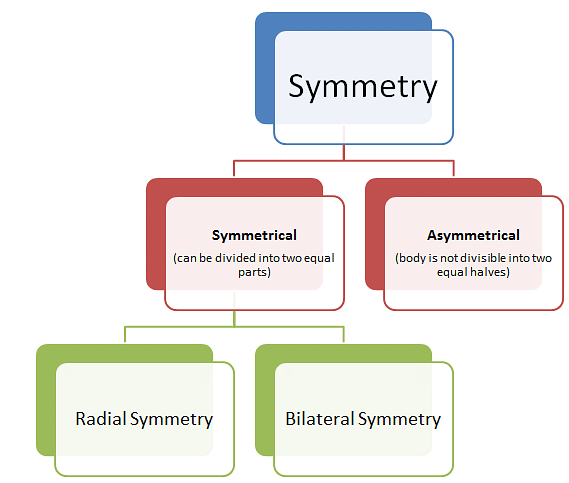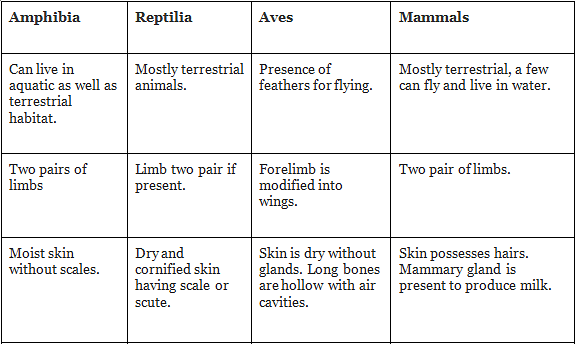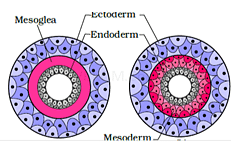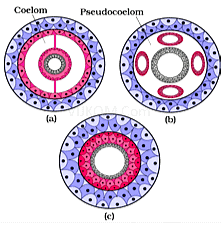NEET Exam > NEET Notes > NCERTs at Fingertips: Textbooks, Tests & Solutions > NCERT Notes: Animal Kingdom
NCERT Notes: Animal Kingdom | NCERTs at Fingertips: Textbooks, Tests & Solutions - NEET PDF Download
Introduction
- Millions of species of animals have been described and it becomes more necessary to classify them to assign a systematic position.
- Animals are classified on the basis of arrangement of cells, body symmetry, nature of coelom, pattern of digestive, circulatory and reproductive system.
 Arrangement of Cells
Arrangement of Cells
 Body Symmetry
Body Symmetry
- Incomplete digestive system has one opening but complete digestive system has two opening:
(i) Mouth
(ii) Anus - Open Circulatory System: Blood is pumped out of heart and cells and tissue are directly bathed in it.
- Closed Circulatory System: Blood is circulated through arteries, veins and capillaries.
- The animals in which cells are arranged in two embryonic layer, external ectoderm and internal endoderm are called diploblastic. Eg. Porifera and Cnidaria.

- The animals in which developing embryo has a third germinal layer, mesoderm besides ectoderm and endoderm are called triploblastic. Eg. Platyhelminthes, Chordates.
- The body cavity which is lined by mesoderm is called coelom. Animals possessing coelom are called coelomate (Annelida, Chordates, Mollusca). In some animals cavity is not lined by mesoderm but scattered as pouches in between ectoderm and endoderm, are called pseudocoelomates. (Aschelminthes). The animals in which body cavity is absent are called acoelomate (Platyhelminthes).

- In some animals, body is externally and internally divided into segments with serial repetition as in earthworm, called metameric segmentation.
Notochord
- Rod like structure formed during embryonic development on the dorsal side.
- It is mesodermally derived.
Example- Chordates.
Classification of Animals
(i) Phylum Porifera
- Members of this phylum are commonly known as sponges. Mostly marine, asymmetrical and have cellular level of organization.
- They have water transport or canal system. Water enters through minute pores, Ostia into central cavity Spongocoel, from where it goes out through Osculum.
- Nutrition, respiration and excretion is performed by pathway of water transport system.
- Skeleton made up of spicules or spongin fibres.
- Egg and sperms are produced by same organism (hermaphrodite). Asexual reproduction by fragmentation and sexual reproduction by gametes formation.
- Fertilisation internal and development is indirect.
Example– Sycon, Spongilla.
(ii) Phylum Cnidaria (Coelenterate)
- They are aquatic, mostly marine, sessile, free swimming, radially symmetrical animals.
- They exhibit tissue level of organization, diploblastic, coelomate with single opening.
- They show two types of body called polyp and medusa.
- Polyp is sessile, fixed, and cylindrical, without gonads. Example: Hydra, Adamsia. Medusa is free swimming, umbrella like having gonads like Aurelia and Jelly fish.
- Some cnidarians exhibits both forms (Obelia). Polyp produce medusa asexually and medusa produce polyp sexually.
(iii) Phylum Ctenophora
- Commonly known as the Comb Jellies or Sea Walnuts.
- Exclusively marine, diploblastic, radially symmetrical, with tissue level of organization.
- Body bears eight ciliated comb plates which help in locomotion.
- Bioluminescence (to emit light) is present in Ctenophores.
- Are Hermaphrodite, fertilisation is external, development indirect.
Example- Ctenoplana, Pleurobranchia.
(iv) Phylum Platyhelminthes (The Flat worms)
- Dorso-ventrally flattened body, bilaterally symmetrical, triploblastic, acoelomate with organs levels of organization.
- Hooks and sucker are present in parasitic forms. Flame cells help in osmoregulation and excretion.
- Fertilisation is internal, development is indirect. They are hermaphrodite.
Example- Taenia, Planaria, Fasciola.
(v) Phylum Aschelminthes (The Round Worm)
- They may be free-living, aquatic, terrestrial or parasitic in plants or animals.
- Bilaterally symmetrical, triploblastic, pseudo coelomate.
- Alimentary canal is complete with well-developed muscular pharynx.
- They are Dioecious. Females are longer than male.
Example- Ascaris (round worm), Wucheriria(filarial worm), Ancyclostoma.
(vi) Phylum Annelida
- Aquatic or terrestrial, bilaterally symmetrical, segmented with organ system level of organization.
- Aquatic Annelids like Nereis possesses lateral appendages parapodia, for swimming. Nephridia help in osmoregulation and excretion.
- Neural system consists of paired ganglia connected by lateral nerves to a double ventral nerve cord.
- Dioecious (Nereis) or monoecious (earthworm, leech)
Example- Pheretima (earthworm), Hirunidaria (Blood sucking leech).
(vii) Phylum Arthropoda
- Largest phylum of animals which includes insects. They have organ system of organization. They are triploblastic, coelomate, bilaterally symmetrical with chitinous exoskeleton.
- Body consists of head, thorax and abdomen, jointed appendages (jointed feet). Respiratory organs are gills, book lungs or tracheal system with open circulatory system.
- Excretion through malpighian tubules, sense organs antenna or eyes. Fertilisation internal, mostly oviparous.
Example:
Economically important – Apis (honey bee), Bombyx (silk worm).
Vectors – Anopheles, Ades, Culex (mosquito).
Living fossils – Limulus (king crab)
(viii) Phylum Mollusca
- Terrestrial or aquatic, organ level of organization, bilaterally symmetrical, triploblastic and coelomate.
- Body divided into head, muscular foot and visceral hump. Unsegmented and covered with calcareous shell.
- Feather like gills are present between hump and mantle.
- Mouth contains file like rasping organ for feeding called radula.
Example- Pila, Octopus.
(ix) Phylum Echinodermata (The Spiny Skinned Animals)
- Endoskeleton of calcareous ossicles, marine with organ system of organization.
- Triploblastic, coelomate, presence of water vascular system help in locomotion, capture of food and respiration.
- Sexes are separate, fertilisation is external and development is indirect.
Example- Asterias (Star fish), Cucumaria (Sea cucumber), Antedon (Sea lily).
(x) Phylum Hemichordata
- Worm-like marine animals with organ system of organization, bilaterally symmetrical, triploblastic and coelomate animals.
- Body is cylindrical, composed of anterior proboscis, a collar and a long trunk.
- Open circulatory system, respiration by gills, excretory organ is proboscis glands.
- Sexes are separate, fertilisation external, indirect development.
Example- Balanoglossus, Saccoglossus.
(xi) Phylum Chordates
- Presence of notochord, have dorsal hollow nerve chord and paired pharyngeal gill slits.
- Bilaterally symmetrical, triploblastic, coelomate with organs system levels of organization.
- Closed circulatory system, ventral heart, post-anal tail is present.

- In Urochordata, notochord is present only in larval tail. In Cephalochordate it extends from head to tail and persists throughout the life.
- Vertebrata possesses notochord in embryonic period which is replaced by vertebral column in the adults.
- Subphylum Vertebrata is further divided into two division Agnatha(lacks jaw) and Gnathostomata (bears jaw).
- Gnathostomata is further divided into two super class- Pisces(bears fins) and Tetrapoda (bears limbs).
(a) Class Cyclostomata (Circular mouthed fishes)
- They are ectoparasites on some fishes. They have sucking and circular mouth without jaws.
- Body devoid of scales, gill slits for respiration, cranium and vertebral column is cartilaginous.
- Circulation is closed type. They are marine but migrate to fresh water for spawning and die after few days. Larva return to seas after metamorphosis.
Example– Petromyzon (Lamprey), Maxine (Hag fish).
(b) Class Chondrichthyes (The Cartilaginous Fish)
- They are marine, streamlined body, have cartilaginous endoskeleton, cold blooded, tough skin with minute placoid scales.
- Gill slits are separate without operculum.
- They have powerful jaw and are predators.
- Air bladder is absent, hence to avoid sinking swims constantly. Heart is two chambered, cold blooded (Poikilothermous).
- Sexes separate. Males have pelvic fins which bear claspers. Internal fertilisation, many are viviparous.
- Electric organ is present in Torpedo and Poison sting in Trygon
Example- Scoliodon (Dog fish), Carcharodron (great white shark).
(c) Class Osteichthyes (The body fish)
- Marine and fresh water both have bony endoskeleton. Streamlined body with four pair of gills covered by operculum.
- Skin is covered with scales, air bladder is present, and heart is two chambered, cold blooded.
- Sexes are separate, fertilisation external, oviparous and development direct.
Example:
Marine - Hippocampus (Sea horse), Exocoetus (Flying fish).
Fresh water- Labeo (Rohu), Catla ,Clarias (Magur).



The document NCERT Notes: Animal Kingdom | NCERTs at Fingertips: Textbooks, Tests & Solutions - NEET is a part of the NEET Course NCERTs at Fingertips: Textbooks, Tests & Solutions.
All you need of NEET at this link: NEET
|
304 docs|275 tests
|
FAQs on NCERT Notes: Animal Kingdom - NCERTs at Fingertips: Textbooks, Tests & Solutions - NEET
| 1. What is the classification of animals? |  |
Ans. The classification of animals is the systematic arrangement of different animal species into various groups or categories based on their characteristics, traits, and evolutionary relationships. It helps in organizing and studying the vast diversity of animal life on Earth.
| 2. How are animals classified in the animal kingdom? |  |
Ans. Animals are classified in the animal kingdom based on their body structure, symmetry, presence or absence of a backbone, presence or absence of specialized tissues, and other distinguishing features. They are categorized into various phyla, classes, orders, families, genera, and species.
| 3. What is the importance of animal classification? |  |
Ans. Animal classification is important because it helps in understanding the evolutionary relationships between different animal species. It allows scientists to study and compare the characteristics, behavior, and adaptations of animals within the same group. Additionally, it aids in identifying and naming new species, as well as in conservation efforts by identifying endangered or threatened species.
| 4. How many phyla are there in the animal kingdom? |  |
Ans. There are approximately 35 recognized phyla in the animal kingdom. Some of the well-known phyla include Chordata (which includes vertebrates), Arthropoda (which includes insects and crustaceans), Mollusca (which includes snails and squids), and Porifera (which includes sponges).
| 5. What are the main characteristics used for animal classification? |  |
Ans. The main characteristics used for animal classification include the presence or absence of a backbone (vertebrates vs. invertebrates), body symmetry (radial vs. bilateral), type of body covering (fur, feathers, scales, etc.), type of digestive system (carnivores, herbivores, omnivores), presence or absence of specialized tissues (nerve, muscle, etc.), and reproductive methods (egg-laying, live birth). These characteristics help in distinguishing and grouping animals into different categories.
|
304 docs|275 tests
|
Download as PDF

|
Explore Courses for NEET exam
|

|
Signup for Free!
Signup to see your scores go up within 7 days! Learn & Practice with 1000+ FREE Notes, Videos & Tests.
Related Searches















